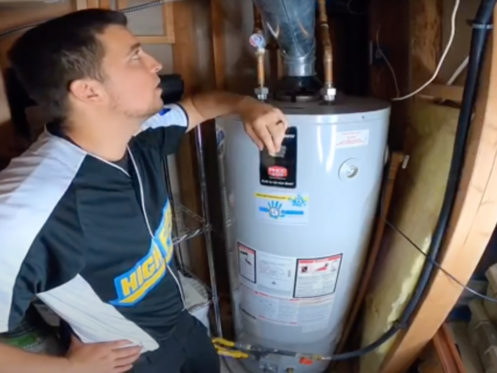We have stumbled upon this post involving How to Maintain a Hot Water Heater in a Few Simple Steps directly below on the net and believe it made good sense to share it with you on my blog.

Warm water is essential for day-to-day comfort, whether it's for a rejuvenating shower or washing meals. To guarantee your warm water system runs efficiently and lasts much longer, regular maintenance is vital. This post provides functional suggestions and insights on how to maintain your home's warm water system to stay clear of interruptions and costly repair work.
Intro
Maintaining your home's hot water system might seem complicated, however with a few basic actions, you can guarantee it operates smoothly for several years to come. This guide covers whatever from recognizing your hot water system to do it yourself upkeep suggestions and understanding when to call in professional assistance.
Relevance of Maintaining Your Hot Water System
Routine upkeep not just extends the lifespan of your hot water system however additionally ensures it operates effectively. Ignoring upkeep can bring about decreased efficiency, greater energy expenses, and also early failing of the system.
Indications Your Hot Water System Requirements Maintenance
Recognizing when your warm water system requires interest can prevent major issues. Look out for indications such as inconsistent water temperature, unusual noises from the heater, or rusty water.
Flushing the Water Heater
Purging your water heater removes debris build-up, boosting performance and lengthening its life.
Monitoring and Replacing Anode Rods
Anode poles stop rust inside the storage tank. Examining and replacing them when worn out is crucial.
Facility Issues Calling For Specialist Assistance
Examples include significant leakages, electrical issues, or if your hot water heater is regularly underperforming.
Routine Specialist Upkeep Perks
Expert maintenance can consist of extensive assessments, tune-ups, and guaranteeing compliance with safety and security criteria.
Checking and Adjusting Temperature Setups
Readjusting the temperature settings makes certain optimum efficiency and safety.
DIY Tips for Upkeep
You can do a number of upkeep tasks on your own to keep your hot water system in leading condition.
Looking for Leaks
Frequently check pipes and links for leaks, as these can lead to water damages and higher costs.
Comprehending Your Hot Water System
Prior to diving into upkeep tasks, it's handy to comprehend the basic elements of your hot water system. Typically, this includes the hot water heater itself, pipes, anode poles, and temperature controls.
Month-to-month Maintenance Tasks
Normal regular monthly checks can aid catch small issues prior to they escalate.
Checking Pressure Alleviation Valves
Testing the pressure safety valve ensures it operates correctly and stops excessive stress buildup.
Protecting Pipelines
Insulating hot water pipelines reduces warmth loss and can save energy.
When to Call a Specialist
While DIY maintenance is valuable, some issues need professional know-how.
Conclusion
Regular maintenance of your home's warm water system is essential for effectiveness, long life, and cost savings. By complying with these tips and understanding when to look for specialist help, you can guarantee a trustworthy supply of hot water without unforeseen interruptions.
How to Maintain an Instant Hot Water Heater
Before tinkering with your hot water heater, make sure that it’s not powered on. You also have to turn off the main circuit breaker and shut off the main gas line to prevent accidents. Also turn off the water valves connected to your unit to prevent water from flowing into and out of the appliance. 2. When you’re done, you have to detach the purge valves’ caps. These look like the letter “T†and are situated on either side of the water valves. Doing so will release any pressure that has accumulated inside the valves while at the same time avoid hot water from shooting out and burning your skin. 3. When the purge valves’ caps are removed, you have to connect your hosing lines to the valves. Your unit should have come with three hoses but if it didn’t, you can purchase these things from any hardware or home repair shops. You can also get them from retail stores that sell water heating systems. Read the user’s manual and follow it to complete this task properly. When the hosing lines are connected, open the purge port’s valves. 4. You should never use harsh chemical cleaners or solutions when cleaning your unit. Make use of white vinegar instead. It should be undiluted and you’ll probably use about 2 gallons. 5. Now flush your water heater. This task should probably take about 40 minutes. We can’t give you specific directions for this because the procedure is carried out depending on the type, model and brand of your heater. With that being said, refer to the user’s manual. 6. When you’re done draining the unit, you have to turn off the purge port valves again. Remove the hosing lines that you earlier installed on each of the water valves. Put the valve caps (purge port) back in their respective places and be very careful so as not to damage the rubber discs that are found inside these caps. 7. Now that everything’s back in place, check your user’s manual again to find out how to reactivate your water heating system. 8. Once it is working, turn one of your hot water faucets on just to let air pass through the heater’s water supply pipes. Leave the tap on until water flows smoothly out of it. https://www.orrplumbing.com/blog/2014/september/how-to-maintain-an-instant-hot-water-heater/

I have been very intrigued by Tips on Maintaining a Water Heater and I'm hoping you enjoyed reading my entry. Sharing is good. One never knows, you could be helping someone out. I love your readership.
Call Today